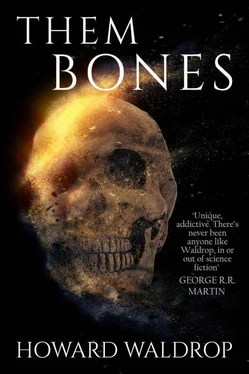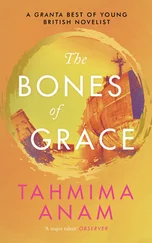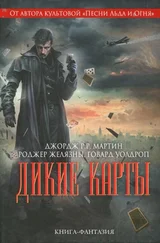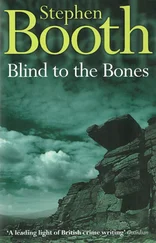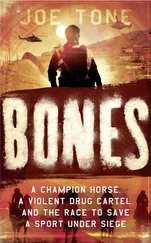Howard Waldrop
THEM BONES
For Leigh Kennedy, who knows what it’s like not to answer the phone for a month.
‘Life can only be understood backward but it must be lived forward.’
– Kierkegaard
‘I often think of the millions and millions of the denizens of time who do not share the time I live in.’
– Claude Ray
‘Out of monuments, names, words, proverbs, traditions, private records and evidence, fragments of stories, passages of books, and the like, we do save and recover somewhat from the Deluge of Time.’
– Francis Bacon
‘The Past isn’t dead. It ain’t even past.’
– William Faulkner
‘There’s a horse in the small mound,’ said Bessie.
Dr. Kincaid sat behind his camp table in the hot tent, his shirt off, smoking his pipe. The kerosene lamp on the table was turned up too high; its chimney was sooty.
On the Berliner Bijou phonograph, its brass horn only inches from Kincaid’s head, Louis Armstrong and His Hot Seven were honking out ‘Potato Head Blues’.
Kincaid, a tall man in his fifties, had been tapping a pencil in time to the music on his field notebook when Bessie walked in. He had only gotten as far as writing ‘June 17, 1929’ across the top of the page. When he listened to music he was oblivious of his surroundings – the heat, mosquitoes, the humidity, the sootiness of the lamp.
Bessie Level waited just inside the netting of the tentflap. She was dressed in jodhpurs, puttees, and khaki shirt and a pith helmet.
Kincaid put the pencil inside his notebook, closed and placed it on the folding camp table. A troubled look came across his tanned face. He stood slowly, reached over and flipped the resonator arm up off the spinning Okeh record, turned off the machine. Then he put the record carefully in its buff sleeve, took his pipe from his mouth, pulled on his white shirt and pushed the tails carefully into his canvas hunting pants. He clipped a black bow tie on his collar, pulled on a jaunty L. L. Bean canvas hat and put his pipe back in his mouth. The whole operation was performed with great deliberation.
He took two long puffs on his pipe; those and the whisper of the kerosene lamp were the only noises in the tent. Outside, Louisiana swamp sounds drifted in – birds, a bullfrog chunk , gleepers, indeterminate mammalian grunts. Kincaid pulled the briar pipe from his mouth.
‘That’s impossible, Bessie,’ he said.
‘I know,’ she said. ‘But it’s a horse, it’s in the smaller mound, and William found it. He said, “Miss Bessie, I found a horse,” I said, “No, William, you didn’t” and he said, “Yes, ma’am, I did! Come look!” and I did. It’s a horse.’
‘Let’s go see it then,’ said Kincaid. He lifted the chimney and blew out the lamp. They stepped from the darkness of the tent into the darkness of the night.
*
‘I’ve already sent William for the acetone,’ said Bessie.
Kincaid’s pipe glowed. The night around them was black, broken only by the ghost outline of the workers’ tent, the only light on the bluff, on whose walls the shadows of the diggers moved. Lightning bugs dotted the air. Bullfrogs roared off in the bayou. Bessie and Kincaid went down the path from the bluff, which stretched away to either side.
Before them, dimly outlined against the waters of the bayou, were the mounds.
Off to their left, on the old flood terrace of the Suckatoncha Bayou, was a mound, designated as Mound One. It was thirty feet in diameter, ten high. Another time and it would have been a promising mound. They would have trenched it first.
But as Bessie and Kincaid walked the path from the campsite, they turned to the right, toward the other mound.
It was two mounds, really, 2A and 2B on the surveys. But the mounds were joined by a small ridge running between them, six feet in height. The larger mound, 2A, was what had drawn them there. It was an irregular mound, the base platform some twelve feet high and fifty-five feet in length to the point where it joined the ridge connecting with the smaller mound. But atop this flat platform of 2A was a conical mound, thirty feet in diameter, whose base was on the platform, and which extended to a curved apex eighteen feet higher.
A platform mound was often an indication of the site of a temple or of a chief’s house. A conical mound was often for burial. In two years of digging, Bessie had never seen a mound so unusual in shape. Neither had Kincaid in his thirty years of archeological work.
They had been as excited about it when they arrived at the site as had the archeologists on the salvage survey the year before. To contain themselves, they had begun by trenching the smaller mound, 2B. They had arrived late that afternoon, set up camp, and staked the mound areas off into five-foot grids, with the apex of 2A as the centerpoint. Kincaid had quit work, as was his custom, as soon as the sun set over the bayou.
‘I thought you’d stopped work,’ he said as they stepped between the stakes toward the smaller mound. The large mound loomed over them to the northeast, with its ridge of connecting earth flowing into the base of the smaller.
2B was a conical lump which rose eleven feet from its base line. It was just over fifteen feet in diameter. On the side opposite the large mound the ridge of earth tapered to a point at ground level.
Viewed from the top, 2A and 2B looked like the ornate fat hour hand of a grandfather clock pointing southwest.
‘There was a little light left, so William kept digging. For the first four feet of the trench, nothing. I’ve got the stratigraphy in my field book. Mixed sand and loam, what you’d expect. A couple of individual earthload impressions, but no containers. We can sift tomorrow, but the first four feet look pretty sterile to me.
‘Then, five feet in, some ash and mica flakes. I had William widen the trench toward the outside. By then it was getting pretty dark. While I labeled the mica and was putting it near the sift box, William found the horse.’
They stood at the edge of mound 2B. The test trench showed as a darker gouge against the grass-covered side of the mound.
Back up on the bluff, a lantern came around the truck and tents and started down the pathway.
‘Miss Bessie?’
‘Down here, William,’ she yelled.
Kincaid’s pipe turned this way and that in the darkness. Bessie could tell that he was imagining this spot the way it was centuries ago. She’d seen him do it on digs the year before. He’d been at the business so long that he could almost make his imaginings come alive. He had, in classes, when she had been an undergraduate. It had changed her life, made her drop her English major, turn to anthropology, go off to become Dr. Level so that she could return to university to work with him.
She was still new enough at it that what she saw was the silent mounds themselves, as if they had once been living things, and had died here, made to give up their mysteries inch by inch, layer by layer, in a sort of dissection. Sometimes they held no mysteries at all – they were just piles of earth with nothing in them, intended for some purpose never carried out.
She had had a feeling about these mounds when she first saw the survey photographs last winter while they were preparing this summer’s salvage. It had been a cool day, and she had imagined digging them in that climate. Now she was here in the middle of a heat wave that made the very air itself seem thick, heavy.
William hurried up with the lantern. He brought the preservation kit – acetone, collodion, varnish, shellac, brushes, picks, gauze, all in a tool box – and set it down.
Читать дальше
